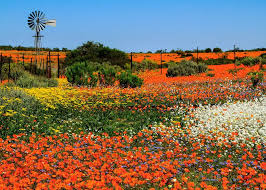Namaqualand:

Scientists recently discovered the world’s oldest inhabited termite mounds along the Buffels River in Namaqualand, dating back 34,000 years.
- Namaqualand is a desert region of southwestern Africa.
- From north to south, it stretches from the Karas region of Namibia to the Northern Cape province of South Africa.
- From west to east, it stretches from the Namib Desert to the Kalahari.
- It covers an area of 400,000 square kilometres.
- The Namibian section, north of the Orange River, is sometimes called Great Namaqualand.
- The South African section, south of the Orange River, is sometimes called Little Namaqualand.
- It is very dry. For a large part of the year succulents are almost the only plants that can be seen on the vast plains.
- Succulents can hold water for long periods and can survive in droughts.
- Rain falls mostly in the winter.
- If there is enough rain, wildflowers cover Namaqualand for a few weeks during springtime.
- The area was traditionally inhabited by the Nama people before the German occupation of the region in the 19th century.
- There are large deposits of copper in Namaqualand.
- The Nama mined them for hundreds of years.
- In the early 1900s diamonds were discovered in several places in Namaqualand, including Sperrgebiet in Namibia and the Richtersveld in South Africa.
- Termites are insects that eat wood.
- They can damage buildings, furniture, and other wooden items.




